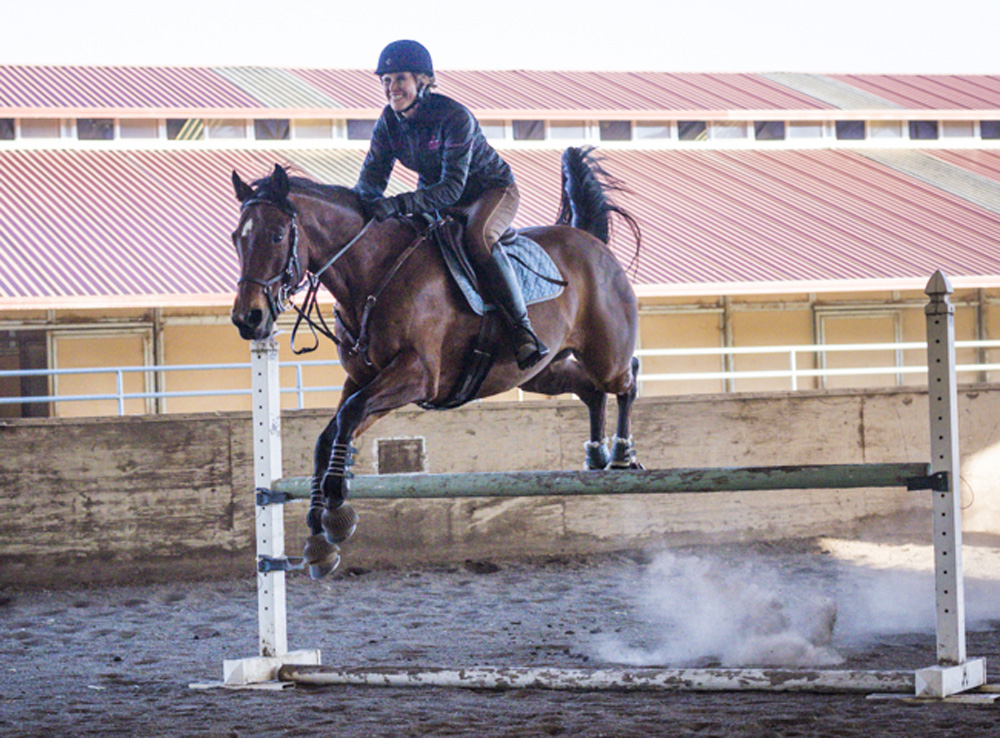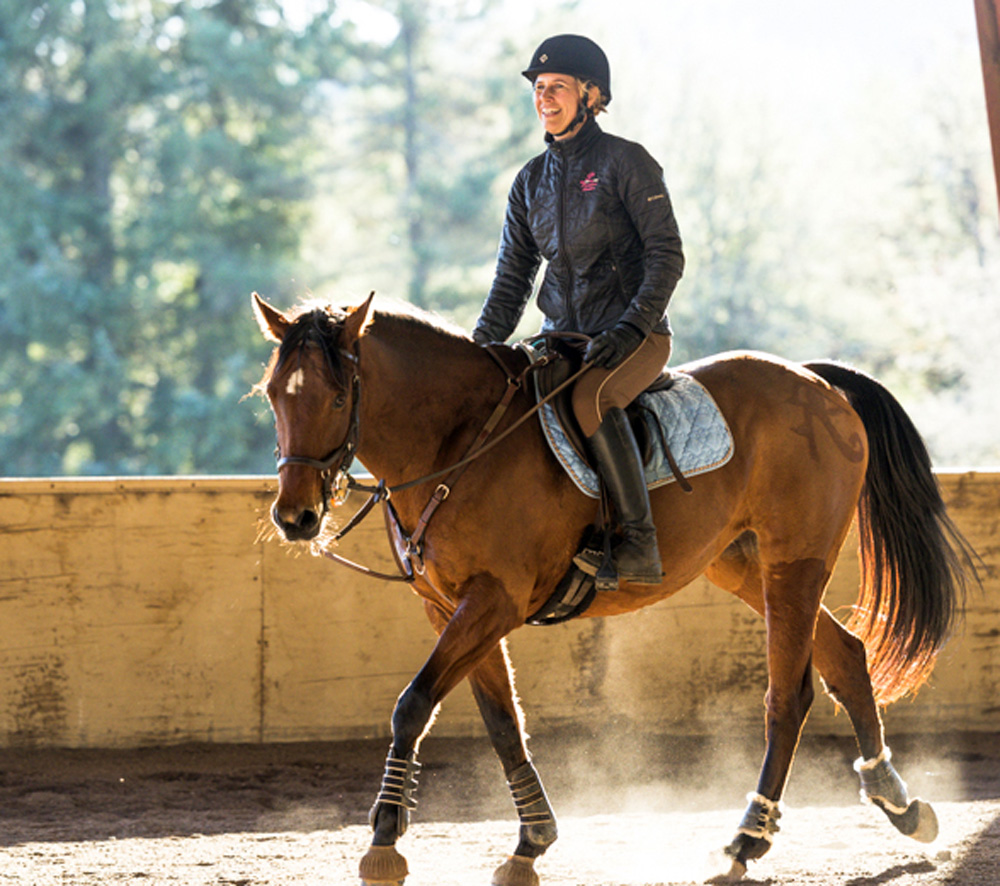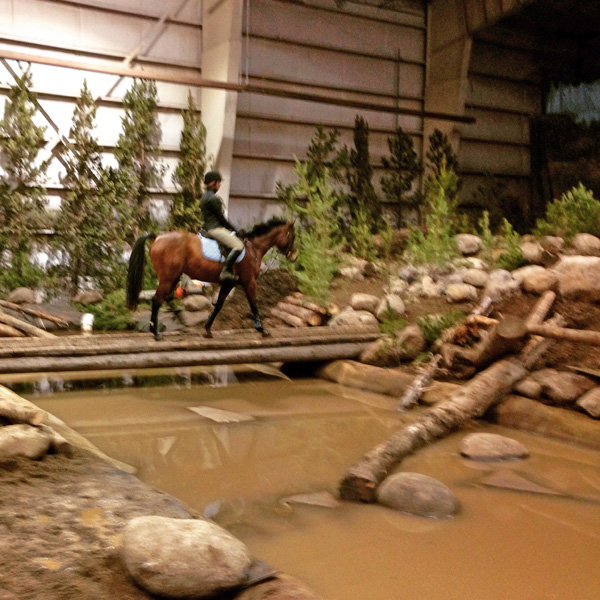I always start off the fall show season reviewing how far we’ve come and what my hot little Irish mare Cairo and I need to work on. A lot of our issues really get down relaxing. Easier said than done. But it led me to think about the difference between a horse that is difficult versus one that is inappropriate for a given rider.
In a lesson with Meika Decher, my event trainer, earlier this fall, Meika had me pull up after a fence that we chipped in order to talk about how to ride the corner better. As we talked, Cairo began to do her rocking horse imitation—it’s a stationary maneuver that’s not a rear or a buck but sort of a low-level combination of both.
It’s the same dance she likes to pull when I’m trying to salute the judge in my stadium round and Cairo just wants to go. I try to discourage it with nonchalance and using my body language to say, “We’re just hanging out.” Cairo does not buy it.
Meika looked at me and said, “What is she doing?” I started laughing and replied, “She’s mad we stopped her from jumping.” We soon got underway, and Cairo was back in her happy place. I heard Meika say, “This is the perfect rider for this horse.”
My equitation is not always perfect, my horse is not something you would look at and says, “Wow, that’s a great amateur mount,” but together we have an awful lot of fun. I laugh at Cairo’s antics and she tackles everything I ask of her.

This mare. She makes me smile!
Sometimes when I watch other riders struggle with fear of the horse they ride, or get hurt, or ask a limited horse to do too much, and I’m aware it’s easy to find yourself with the wrong horse. And it’s so hard to deal with that because we put so much love and emotion into these animals. For a lot of us amateurs, even the highly competitive ones, our horses are pets or family members and it’s hard to sell them, even if you are falling off or if riding your horse is scaring you.
I’m lucky that I found the horse of my dreams, albeit in a small, hot package. For every rider that looks at Cairo glaring her way through a dressage test and tells me, “I can’t believe you put up with that,” there is another rider who sees her jump and says, “If I was 10 years younger, I’d love to have that horse.” (Apparently Cairo is a mid-40s and younger kind of mount.)
Despite our struggles with dressage and Cairo’s fiery nature, she is a totally appropriate horse for me. I look forward to every ride on her; she’s super-talented; she doesn’t remotely scare me (or my trainers), and in fact her courage on cross-country and love of jumping builds my confidence hugely. She might have a terrible case of “resting mare face” in dressage, but her expression swings to mad glee when we are out galloping.
And I adore her—did I mention that? So her drunken swerves down the centerline or little half-rear at E to protest having to trot instead of canter make me laugh, even when it means we don’t always finish in the ribbons.
But hope springs eternal and when I came home from watching and writing about the Charlotte Dujardin clinic at Oregon’s Devonwood Equestrian Center in October I was all lit up with eagerness to hop on Cairo and apply all I had learned. One thing that had really stood out, visually, was watching Charlotte get on a horse with a perfectly nice trot, add suspension and suddenly have a brilliant trot: A little leg, a little half-halt and a lot of glorious movement.
As good clinicians do, she left her auditors eager to head home and try out their new knowledge on their own steeds.
What was also lurking in the back of my mind as I sped right from the clinic to the barn was Charlotte’s lovely British accent saying things like when she’s looking at horses she likes mares, goes for temperament and a good but not huge walk and a good canter.
ADVERTISEMENT
Well, Cairo is most definitely a mare, and she has a great canter. So there’s that.
She also has a rather large walk and the temperament of a tiger. Come to think of it, her walk is strangely similar to the strut of a panther. (And like most cats, she is very cuddly, on her own terms.)
But now that I think about it, when Charlotte says she looks for temperament, I don’t think “small mare, big cat attitude,” is what she is thinking.
Let’s just say that despite all the visions of gorgeous trot suspension dancing in my head, watching an top Olympian coach riders on lovely horses through travers and pirouettes all weekend did not actually translate into my suddenly being able to persuade Cairo that trotting 20-meter circles is even remotely a good use of her time.

One of my essential aids for flatwork is a sense of humor!
Cairo is fast and sassy; she’s opinionated. Very opinionated. It’s easy to get your feelings hurt when people, rather than sympathize with your sassy mare problem, look at you like you are nuts. Our dressage scores suffer, and well-meaning people say anything from, “Why do you ride her?” to “Have you had her teeth looked at?”
Answers: Because I love her and she thinks she can jump the moon; and yes, every six to nine months. She also gets raspberry leaves, expensive joint supplements, probiotics … am I forgetting anything?
But for every time someone says something snarky, there’s a moment like last May when Cairo gleefully leaped over a cross-country table in a clinic with Dom Schramm and my trainer Meika snapped a photo of Cairo mid gleeful leap. She showed it to Dom who laughed and said, “Photoshop that over the first table at Rolex.” (Of course he also kept referring to her, affectionately, as “crazy girl.”)
The first thing I did to kick autumn off was to get Cairo’s teeth done and get her some bodywork. I’m a big believer in making sure any behaviors my horse might be having aren’t pain related. I also I got her a rabies vaccination. There was a rabid bat found not that far from the barn and I wanted to make sure any weird frothing at the mouth Cairo does is dressage, not disease, related.
My dressage trainer Leslie Chapman has an exercise that we call “putting baby in the corner.” We call it this because Cairo subscribes to the Dirty Dancing theory of life in which “nobody puts Baby in a corner,” and the bad kids are always sexy. The things Cairo hates most in the world are standing still and trotting, followed by walking at a reasonable pace (fast walking with big, giant steps is cool). So Leslie sometimes just makes Cairo stand quietly in the corner. There is much gnashing of teeth and mare-face.
Cairo hates anything that makes her feel boxed in. My friend Becky, who bred her, tells me that within moments of being born, Cairo leaped to her feet (like a baby mule, Becky says, but I try to tune that part out).
No staggering and getting her feet under her for that filly. Boom. Ready to rock and roll. Cairo is a free spirit, and certain activities, like dressage, cramp her style.
Sometimes I think maybe I am cramping Cairo’s style. Maybe a pro could peel through her layers faster than I can—I like to say she’s a mystery, wrapped in an enigma, soaked in hot sauce. But then again, it’s my journey with my mare and I don’t have time limits on getting my horse figured out. I’m enjoying the ride with the help of understanding trainers who totally get why I love my horse.
ADVERTISEMENT
I had a trainer tell me once that when it comes to the truly talented horses, many of them tend to be freaks and sometimes you have to think outside the box to let them shine. Look at the upper level jumpers like Snowman, who stumbled over trot poles but soared over massive fences, or Samsung Woodstock who showed in “war bridle” of just a bit, chinstrap and reins.
So thinking outside the box is one of my winter goals. I’ve experimented with bits and bitlessness and concluded Cairo likes only thin, soft rubber bits like Nathe. And Cairo and I have added on a couple of extra adventures to find different ways to channel her energy.
We tried some more hunter/jumper shows instead of only horse trials. In October, we competed in a local show circuit’s equitation final. We got fourth. Out of four. But as we sashayed out of the ring, red tail ribbon in full effect, the judge smiled and said, “I’m sure you will do much better in the jumper class.”
Yup. We won that one. I realized that inside turns, which I hardly ever have to do eventing, are a great reminder to ride off your leg and maintain balance, and Cairo rocked it.
In November, after the close of the National Mountain Trail Championships at the Oregon Horse Center, I took Cairo over to school the course. Apparently Cairo doesn’t mind walking if what we are walking over are narrow bridges, rock and timber filled trails and clambering over wooden boxes.
She a balked in only two places. There was a seesaw bridge that she was startled by—she’s never had to walk over a bridge that suddenly tips down—and after she went over it once, she figured there was no need to do that again. And there was a gate with carwash-like strips hanging down in the water obstacle that she didn’t appreciate.
Other than that, Cairo walked calmly and elegantly around the course. Watching her, my friend Emily suggested we try to persuade future event organizers to rig the dressage arena with a series of narrow bridges and catwalks, more suited to Cairo’s unique style than a mere rectangle of sand.

When she balked, I nudged her with my heels and clucked. After staring it down for a while, she gamely tackled the seesaw bridge, but the strips in the water pissed her off. I nudged harder. She backed up. Emily offered me her crop, and I took it. I had barely touched her with it when Cairo surged forward and stomped through the gate and its pesky strips all the while swishing her tail to let me know that she is not the kind of mare who needs a crop.
And then I realized I haven’t used a crop on her all year. Sure, I carry one sometimes, but I never have to use it. Cairo is so game that the most I ever have to do is cluck. So there you are, she may be kind of little, she has a funny scar on her hock, a tendency to glare when other horses get in her bubble and a terrible disgust for dressage, but she tries her heart out for me and I wouldn’t trade her for the moon. I might be willing to sell my soul at a crossroads to up my dressage scores, though…
Camilla Mortensen is an amateur eventer from Eugene, Ore., who started blogging for the Chronicle when she made the trek to compete in the novice level three-day at Rebecca Farm in Montana. Camilla works as a newspaper reporter by day and fits training and competing Cairo into her days.
Read all of Camilla’s adventures with Cairo…














